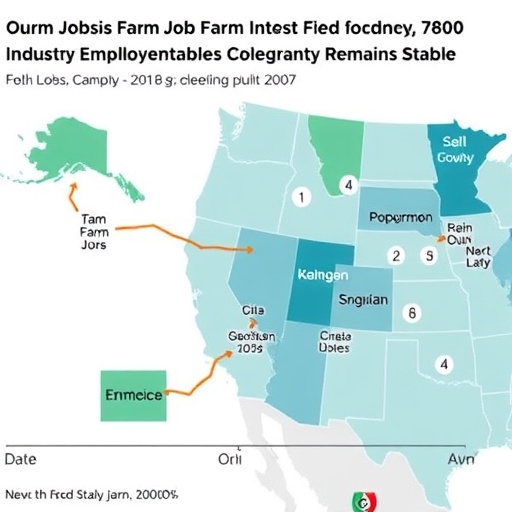As Farm Employment Declines, the Food Industry Emerges as a Stable Economic Force
For nearly three decades, a comprehensive global study led by researchers at Cornell University has traced the dramatic shifts in employment patterns across the agricultural and food sectors in 189 countries. Challenging long-standing classical economic theories that envision a direct, almost linear migration of labor from farms to factories during economic development, the new research reveals a more nuanced transformation. Instead of a simple exodus from agriculture to manufacturing industries, the workforce is increasingly redistributing within the sprawling agrifood value chain itself—culminating in a remarkably stable employment landscape across food processing, distribution, retail, and hospitality sectors.
This novel insight emerges from meticulous analysis of employment data spanning multiple decades, contextualized within varying degrees of national economic growth. The researchers argue that consumer demand, rather than improvements in agricultural productivity alone, primarily drives this complex realignment within the agrifood system. As populations grow wealthier, dietary preferences evolve toward greater convenience, safety, and diversity, fostering significant labor demand not only in food manufacturing but increasingly downstream in food retail and service industries.
Cornell’s Professor Chris Barrett, an expert in applied economics and management, underscores the magnitude of these dynamics. He explains that rising incomes shift consumer behavior in ways that ripple across the entire agri-food supply chain. This shift creates multifaceted employment opportunities extending well beyond traditional farming roles and even beyond the manufacturing-centered jobs often highlighted in economic narratives of structural transformation. The expanding food services and retail sectors have now reached employment levels that match or surpass farm labor in wealthier economies—a striking reversal of historical norms.
The transition out of farming into midstream (processing, logistics, and distribution) and downstream (retail and food services) sectors carries substantial wage implications. Workers departing agricultural labor generally experience income improvements due to safer working conditions and better remuneration. Yet, this transition also exposes—and, in many cases, exacerbates—gender-based disparities in pay. While men disproportionately move into midstream jobs associated with higher wages, women are more likely to enter downstream service roles such as restaurants and retail outlets, sectors which consistently offer lower compensation.
This gendered division in labor segments within the food system highlights a growing divide in earnings between men and women. Whereas men’s wages benefit from the more lucrative midstream positions, women’s increased participation in service sector roles contributes to a persistent, if not widening, gender pay gap. Statistical analysis indicates that as nations develop economically, the ratio of women’s to men’s average earnings in the food system declines from near parity in low-income agrarian societies to approximately 94 cents on the dollar in richer economies. This figure likely underrepresents the true disparity since subtler within-sector pay gaps remain difficult to capture through broad data.
The implications of these findings resonate beyond academia, presenting complex challenges for policymakers striving to balance rural development, economic growth, and social equity objectives. In particular, the study raises critical questions about initiatives seeking to lure younger generations back to farming—a trend observed in some countries aiming to revive rural economies. These well-intentioned efforts may clash with economic realities, given that job growth now predominantly occurs outside traditional agricultural employment. Instead, the expanding roles within food processing, distribution, retail, and food service sectors represent the engine of agrifood employment growth.
Beyond employment volume, the study also sheds light on structural inequalities embedded within the evolving food economy. The stark gender differences in occupational Segregation and resulting pay gaps spotlight the need for nuanced labor policies and interventions. Addressing these disparities requires targeted strategies to elevate the quality and remuneration of service-sector jobs—fields where women increasingly find employment—as well as efforts to broaden their participation in higher-wage midstream roles historically dominated by men.
Furthermore, the research reshapes our understanding of structural transformation—a fundamental concept in development economics. Rather than a straightforward reallocation of workers from primary agriculture to manufacturing factories, transformation is now understood as a complex reorganization within an integrated agrifood system that spans production, processing, logistics, and services. This more dynamic model better reflects the heterogeneity of modern economies and consumer preferences that collectively reshape labor markets.
The study’s global scope, encompassing countries at various developmental stages, enhances its relevance and applicability. Observing nearly thirty years of change, it captures how differing economic trajectories influence worker transitions, wage dynamics, and sectoral employment patterns. These findings elevate the agrifood system as a vital focus for future economic and social policies aimed at fostering inclusive growth, job creation, and gender equity in the evolving global food landscape.
Lastly, the researchers advocate for additional detailed data collection and analysis on within-industry wage disparities to further illuminate the depth and nuances of gender pay gaps across agrifood sectors. Disentangling the specific factors contributing to pay inequality requires granular occupational and demographic data that can inform more equitable labor market interventions.
In sum, the Cornell University study delivers a sobering yet insightful update to the economic narrative of structural transformation, underlining the food industry’s pivotal and evolving role in global employment landscapes. It invites policymakers and stakeholders alike to rethink strategies for labor market development—shifting attention from traditional farming to the broader, multifaceted food value chain, with a keen focus on addressing persistent gender inequities and supporting sustainable, inclusive economic growth.
Subject of Research: People
Article Title: Agrifood value chain employment and compensation shift with structural transformation
News Publication Date: 10-Sep-2025
Web References:
- Original Article in Nature Food: https://www.nature.com/articles/s43016-025-01225-9
- Cornell Chronicle Story: https://news.cornell.edu/stories/2025/09/farm-jobs-decline-food-industry-work-holds-steady
Keywords:
Agriculture, Economics research, Domestic commerce, Farming, Food production




